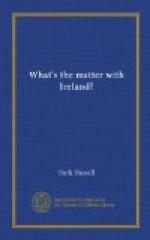Bread-and-tea, and bread-and-tealess families get on the calling list of tuberculosis nurses. “The nurses often found,” writes the Woman’s National Health Association, “that a large number of cases committed to their care were in an advanced stage of the disease ... in a number of cases families have been found entirely without food. This chronic state of lack of nourishment ... accounts in part for the fact that there are two and sometimes three persons affected in the same family."[10]
Has mental as well as physical health been affected? Lunacy is extraordinarily prevalent in Ireland. In the lunacy inspectors’ office in Dublin castle, I was given the last comparison they had published of the insanity rates in England and Wales, Scotland and Ireland. English and Welsh insanity per 10,000 people was 40.8; Scottish, 45.4; Irish, 56.2. The Irish rate for 1916 showed an increase to 57.1.[11]
Emigration, remark lunacy experts, fostered lunacy. Whole families withdrew from certain districts. Consanguineous marriages became more frequent. Weak-minded cousins wedded to bring forth weaker-minded children.
And Irish living conditions are a nemesis. They affect those who go as well as those who stay. Commenting on the fact that the Irish contribute the highest proportion of the white foreign-born population to the American hospitals for the insane, as well as filling their own asylums, the lunacy inspectors write: “As to why this should be, we can offer no reasoned explanation: but just as the Irish famine was, apart from its direct effects, responsible for so much physical and mental distress in the country, so it would seem not improbable that the innutritious dietary and other deprivations of the majority of the population of Ireland must, when acting over many generations, have led to impaired nutrition of the nervous system, and in this way have developed in the race those neuropathic and psychopathic tendencies which are precursors of insanity."[12]




